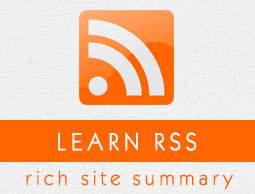What is RSS?
RSS is an open method for delivering regularly changing web content. Many news-related sites, weblogs, and other online publishers syndicate their content as an RSS Feed to whoever wants it.
Any time you want to retrieve the latest headlines from your favorite sites, you can access the available RSS Feeds via a desktop RSS reader. You can also make an RSS Feed for your own site if your content changes frequently.
In brief:
RSS is a protocol that provides an open method of syndicating and aggregating web content.
RSS is a standard for publishing regular updates to web-based content.
RSS is a Syndication Standard based on a type of XML file that resides on an Internet server.
RSS is an XML application, which conforms to the W3C's RDF specification and is extensible via XML.
You can also download RSS Feeds from other sites to display the updated news items on your site, or use a desktop or online reader to access your favorite RSS Feeds.
What does RSS stand for? It depends on what version of RSS you are using.
RSS Version 0.9 - Rich Site Summary
RSS Version 1.0 - RDF Site Summary
RSS Versions 2.0, 2.0.1, and 0.9x - Really Simple Syndication
What is RSS Feed?
RSS Feed is a text XML file that resides on an Internet server.
An RSS Feed file includes the basic information about a site (title, URL, description), plus one or more item entries that include - at a minimum - a title (headline), a URL, and a brief description of the linked content.
There are various flavors of RSS Feed depending on RSS Version. Another XML Feed format is called ATOM.
RSS Feeds are registered with an RSS registry to make them more available to viewers interested in your content area.
RSS Feeds can have links back to your website, which will result in a high traffic to your site.
RSS Feeds are updated hourly (Associated Press and News Groups), some RSS Feeds are updated daily, and others are updated weekly or irregularly.
How Does RSS Work?
This is how RSS works:
A website willing to publish its content using RSS creates one RSS Feed and keeps it on a web server. RSS Feeds can be created manually or with software.
A website visitor will subscribe to read your RSS Feed. An RSS Feed will be read by an RSS Feed reader.
The RSS Feed Reader reads the RSS Feed file and displays it. The RSS Reader displays only new items from the RSS Feed.
The RSS Feed reader can be customized to show you content related to one or more RSS Feeds and based on your own interest.
News Aggregators and Feed Readers
RSS Feed readers and news aggregators are essentially the same thing; they are a piece of software. Both are used for viewing RSS Feeds. News aggregators are designed specifically to view news-related Feeds but technically, they can read any Feeds.
Who can Use RSS?
RSS started out with the intent of distributing news-related headlines. The potential for RSS is significantly larger and can be used anywhere in the world.
Consider using RSS for the following:
New Homes - Realtors can provide updated Feeds of new home listings on the market.
Job Openings - Placement firms and newspapers can provide a classified Feed of job vacancies.
Auction Items - Auction vendors can provide Feeds containing items that have been recently added to eBay or other auction sites.
Press Distribution - Listing of new releases.
Schools - Schools can relay homework assignments and quickly announce school cancellations.
News & Announcements - Headlines, notices, and any list of announcements.
Entertainment - Listings of the latest TV programs or movies at local theatres.
RSS is growing in popularity. The reason is fairly simple. RSS is a free and easy way to promote a site and its content without the need to advertise or create complicated content sharing partnerships.


